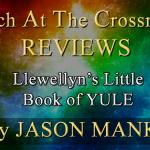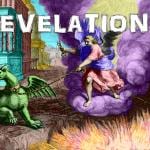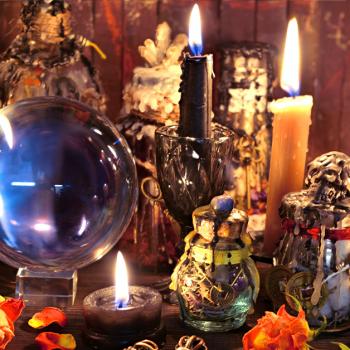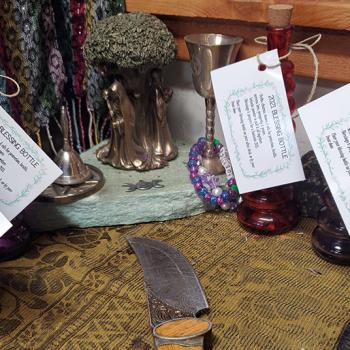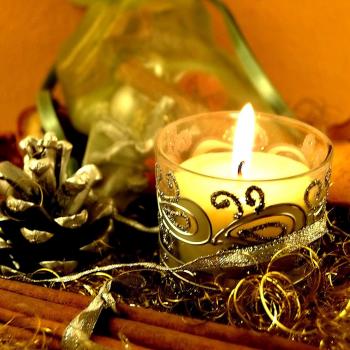Solitary Wicca practice can be challenging, rewarding, isolative, and intense. An excellent guidebook makes a fantastic foundation on which to build a solitary practice and I write this review from that perspective.
Love Me Some Wicca
I have a special place in my heart for Wicca, even though it no longer identifies what I do in the magical world. I was Wiccan for around twenty-five years, going through training in various traditions. During that time, I read extensively and ran my own circles and covens across the country. When I married my second husband in 1997, I was halfway or so through my experience as a Wiccan. He started training with a local Gardnerian coven and found it wasn’t for him (the coven, not the practice). Shortly after he left that group, we created our own tradition layered onto the CUSP structure. Even though the CUSP tradition adapts to almost any religious path, the interpretation we used in the circle we ran together for over twenty years was eclectic Wiccan based.
After my own practice chanced so much that I no longer felt accurate in identifying specifically as Wiccan, I still taught Wicca 101 classes in my shop. I never stopped loving the pageantry, the mythology, and ritual foundation. For those who are called to it, Wicca is a gracious, sacred, and uplifting practice and I honor it as my gateway drug into the world of magic and Paganism.
Reading Was Fundamental For Me
Because I started my magical practice in the 1980s, I got to be around when all of the classic references we honor now were new and exciting. Buckland’s Complete Book of Witchcraft published in 1986. The Spiral Dance by Starhawk came out in 1979. Wicca: A Guide for the Solitary Practitioner by Scott Cunningham released in 1988 and To Ride A Silver Broomstick by Silver Ravenwolf came out in 1993. During the scope of my Wiccan practice, metaphysical books boomed from one tiny shelf of classics to Wiccan authors falling all over one another with publications. It was, frankly, a fantastic time to be Wiccan.
I worked as a library aide during that time and thanks to the Interlibrary Loan program, the good ol’ ILL, I read almost every book on magic, Witchcraft, Wicca, or the occult that I could find. This ranged from the most obscure to the most fluffy bunny rainbows and unicorn stuff. I couldn’t get enough of it. That all being said, life moved on and things changed and my spiritual needs shifted and eventually my identification with Wicca lessened although my appreciation for it did not.
The Challenge of Wiccan Writing Today
In current times, when a person writes a book about Wicca, they have big, pointy-toed shoes to fill (or Birkenstocks, depending on the tradition). The great books about Wicca are written for the most part and it is almost as though there is no longer anything new under the sun where the topic is concerned. The last Wicca books to impress me were Progressive Witchcraft by Janet Farrar and Gavin Bone published in 2004, Traditional Wicca by Thorn Mooney published in 2018, and Transformative Witchcraft by Jason Mankey, published in 2019. I am a tough sell where Wicca books are concerned because I have read most of the best. If you write a book about Wicca these days, you must have something new or innovative to say about it to impress me.
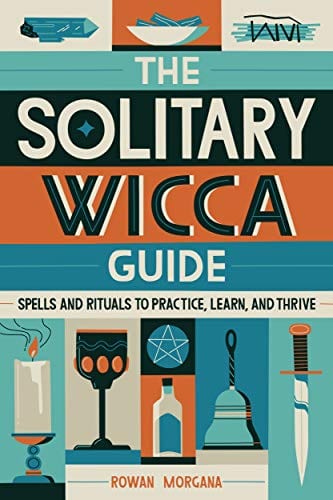 I have good things to say about the focus book for this article, The Solitary Wicca Guide: Spells and Rituals to Practice, Learn, and Thrive by Rowan Morgana.
I have good things to say about the focus book for this article, The Solitary Wicca Guide: Spells and Rituals to Practice, Learn, and Thrive by Rowan Morgana.
Kudos
- Rowan Morgana is a lovely writer who can turn a phrase with magical articulation where rituals and spells are concerned. The seventy-one pages of this book dedicated to spells and rituals are absolutely beautiful and will serve any Wiccan, new or experienced, quite well. For those not given to writing their own work, this is a great go-to book.
- The book is attractive with (gasp!) color accents inside. It is rare that we find a publisher that extends the effort to make books as visually appealing on the inside as they are on the outside and this book goes the distance on that. I suspect Adobe’s stock jumped a point or two with the use of these Illustrator vector images.
- She introduces “new to me” conceptualizations of the God energy as “Hero, Lover, King, & Sorcerer” and further divides those archetypes into Dark and Light, Sun and Moon aspects. I love hearing about the ways other people engage Divine energy and the author’s discussion of this was quite interesting.
- Although she does include the obligatory trope of an altar layout design (minus a God & Goddess figure?), she does mention that the tools suggested in her “The Well-Stocked Solo Wiccan” chapter are “useful” and not “required.” This is a relief for under-funded Wiccans who once had to go mad trying to find a white handled boleen for herb cutting or else feel the hateful sting of inadequacy.
- In ritual work, we releases the circle counter-clockwise, which resonates for me since it is how I was trained.
Cringes
The challenge with this book is its packaging. Had the publishers marketed it as a Wiccan Book of Shadows rather than a comprehensive guide to solitary work, it would live up to its presentation and then some. Introducing “Solitary Wicca Guide” into the title invites unavoidable comparisons to the classic books that came before it that actually delivered what the title promised. This book misses the mark on this on several key points.
- Although the author explores new archetypes for the God energy, the Goddess energy remains as the traditional “Maiden, Mother, Crone” progression. There is no explanation for the imbalance of four faces of the God with only three faces of the Goddess or why she did not further consider new faces for the Goddess as well.
- She offers the approach that the God and Goddess are duality aspects of the “Universal Energy of The One, which gives form and life to all existence” (Page 10) without making room for the multitude of Wiccans who see their Gods and Goddesses as individual, unique beings that do not ultimately form a collective consciousness of Divinity. Might want to give that popular concept at least a mention.
- There is no, and I do mean zero, substantial discussion of the rich history of Wicca. The history section consists of a section called “The Roots of Belief” that takes up approximately three-fourths of a page with only a short paragraph within that section discussing history. Since presumably a solitary Wiccan does not mingle with other Wiccans in a coven community to pick up on historical information by osmosis or training, I would think a solitary Wicca guide would offer more than simply saying that Gerald Gardner started Wicca in the 1940s and it was really hard to find a coven back then (paraphrased). To this end, the book is marketed as a guide for solitary Wiccans while providing no information at all for what they are practicing or how it developed. In my Wicca 101 classes, we spend an entire two hour class solely on the history of Wicca. Understanding the foundation on which a belief system is created is fundamental to its practice.
- In fact, only approximately twenty pages of the book are even about Wicca. There is a brief mention of seven potential candidates for Goddess worship (no Gods mentioned), then a whopping seventy-one pages dedicated to spells and rituals, which, as previously mentioned, are excellent. Thirty-three pages are recipes for ritual food, 46 pages are apothecary recipes for powders, oils, and washes, and then three full pages are additional resources, including classic books for solitary Wiccan practitioners that do cover the above information, plus her own website.
In summary
It’s not a bad book at all, it is simply marketed in a way that creates expectations that the book cannot deliver in its current state. The information is excellent, but does not, in my opinion, meet the criteria one would expect from a guidebook for an entire practice, especially a solitary one.
PS: I do not intend all of my blog posts to be reviews. The heat and the current energetic upheaval have my thoughts in a bit of a jumble and book reviews are a safe place for me right now.


